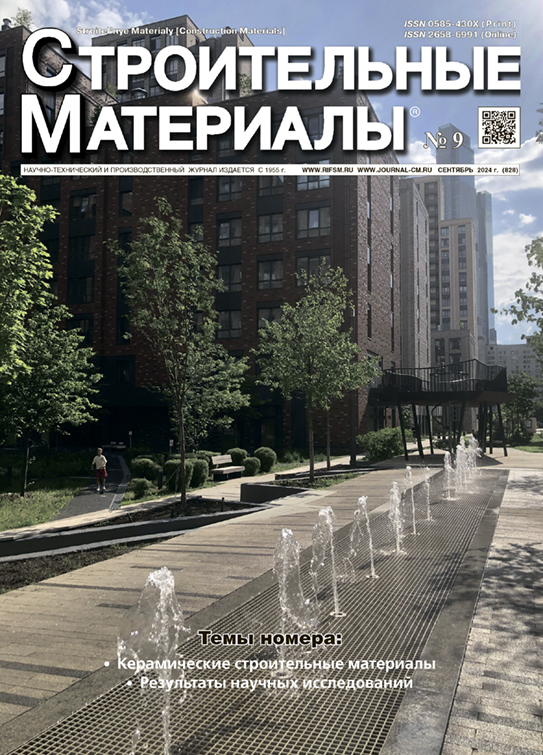Мелкозернистый бетон с добавкой высокодисперсного порошка кирпичного боя
- Авторы: Дроздюк Т.А.1, Айзенштадт А.М.1, Першин З.А.1, Данилов В.Е.1
-
Учреждения:
- Северный (Арктический) федеральный университет имени М.В. Ломоносова
- Выпуск: № 9 (2024)
- Страницы: 30-35
- Раздел: Статьи
- URL: https://rjeid.com/0585-430X/article/view/636795
- DOI: https://doi.org/10.31659/0585-430X-2024-828-9-30-35
- ID: 636795
Цитировать
Полный текст
Аннотация
Применение кирпичного боя в бетонах и в вяжущих композициях является перспективным направлением развития вторичной переработки керамического кирпича. Целью настоящих исследований является оценка возможности использования минеральных порошков, полученных из кирпичного боя, в качестве эффективного дисперсного компонента при производстве мелкозернистого бетона. В работе проводилось механическое измельчение керамического сырьевого материала при различной продолжительности помола. Установлено, что для порошков кирпичного боя увеличение продолжительности помола не приводит к пропорциональному увеличению удельной поверхности порошков. Максимальный эффективный прирост удельной поверхности получаемых порошков фиксируется при продолжительности помола до 5 мин. С помощью дифференциально-термического анализа показано, что измельченный кирпичный бой не является активной минеральной добавкой, а может выполнять роль центров кристаллизации при образовании гидросиликатов в структуре композитов. Были изготовлены образцы мелкозернистого бетона, в которых часть цемента была заменена на керамические порошки, полученные при различной продолжительности помола. Определено, что замена в бетонных смесях цемента данной высокодисперсной добавкой в количестве 20 мас. %, полученной при оптимальной продолжительности помола на шаровой мельнице, не приводит к изменению физико-химических характеристик конечного бетонного композита.
Полный текст
Об авторах
Т. А. Дроздюк
Северный (Арктический) федеральный университет имени М.В. Ломоносова
Автор, ответственный за переписку.
Email: t.drozdyuk@narfu.ru
канд. техн. наук
Россия, 163002, г. Архангельск, наб. Северной Двины, 17А. М. Айзенштадт
Северный (Арктический) федеральный университет имени М.В. Ломоносова
Email: a.isenshtadt@narfu.ru
д-р хим. наук, профессор
Россия, 163002, г. Архангельск, наб. Северной Двины, 17З. А. Першин
Северный (Арктический) федеральный университет имени М.В. Ломоносова
Email: pershenz@gmail.com
магистрант
Россия, 163002, г. Архангельск, наб. Северной Двины, 17В. Е. Данилов
Северный (Арктический) федеральный университет имени М.В. Ломоносова
Email: v.danilov@narfu.ru
канд. техн. наук, доцент
Россия, 163002, г. Архангельск, наб. Северной Двины, 17Список литературы
- Владимиров С.Н. Проблемы переработки отходов строительной индустрии // Системные технологии. 2016. № 2 (19). С. 101–105. EDN: WCNXNV
- Hammadhu Haither Ali, Anjali G. Sustainable urban development: Evaluating the potential of mineral-based construction and demolition waste recycling in emerging economies. Sustainable Futures. 2024. Vol. 7. 100179. https://doi.org/10.1016/j.sftr.2024.100179
- Гончарова М.А., Борков П.В., Аль-Суррайви Х.Г.Х. Рециклинг крупнотоннажных бетонных и железобетонных отходов при реализации контрактов полного жизненного цикла // Строительные материалы. 2019. № 12. С. 52–57. https://doi.org/10.31659/0585-430X-2019-777-12-52-57 EDN: KNFINX
- Sahoo P., Dwivedi A., Tuppad S.M., Gupta S. Sequestration and utilization of carbon dioxide to improve engineering properties of cement-based construction materials with recycled brick powder: a pathway for cleaner construction. Construction and Building Materials. 2023. Vol. 395. 132268. https://doi.org/10.1016/j.conbuildmat.2023.132268
- Яценко Н.Д., Яценко А.И. Использование промышленных отходов для повышения эксплуатационных свойств керамического кирпича // Строительные материалы. 2024. № 4. С. 37–42. https:// doi.org/10.31659/0585-430X-2024-823-4-37-42 EDN: BEDDFU
- Муртазаев С.-А.Ю., Хадисов В.Х., Хаджиев М.Р. Использование керамического кирпичного боя для получения легких керамобетонов // Экология и промышленность России. 2014. № 10. С. 22–25. EDN: SQVWOD
- Беппаев З.У., Аствацатурова Л.Х., Колодяжный С.А., Вернигора С.А. Перспективы применения рециклингового щебня из боя керамического кирпича в качестве заполнителей для производства бетонов общестроительного назначения // Вестник НИЦ «Строительство». 2020. Т. 24. № 1. С. 13–22. https://doi.org/10.37538/2224-9494-2020-1(24)-13-22 EDN: DIPMOP
- Махортов Д.С., Загороднюк Л.Х., Сумской Д.А., Аль Мамури С.К.Ш. Получение вяжущих композиций оптимальных составов на основе портландцемента и отходов боя керамического кирпича // Вестник Белгородского государственного технологического университета им. В.Г. Шухова. 2022. № 7. С. 19–30. https://doi.org/10.34031/2071-7318-2022-7-7-19-30 EDN: QZAHQL
- Украинский И.С., Майорова Л.П., Саликов Д.А. Шевчук А.С., Чайников Г.А. Повторное использование бетонного и кирпичного лома в качестве заполнителей в бетон // Вестник Российского университета дружбы народов. Сер.: Экология и безопасность жизнедеятельности. 2023. Т. 31. № 2. С. 291–301. https://doi.org/10.22363/2313-2310-2023-31-2-291-301 EDN: NENFHQ
- Муртазаев С.-А.Ю., Успанова А.С., Хаджиев М.Р., Хадисов В.Х. Анализ влияния техногенных отходов в виде отсевов дробления керамического боя на основные свойства цементных композитов // Строительные материалы и изделия. 2021. Т. 4. № 1. С. 27–34. EDN: LJVZGS
- Галаева Н.Л. Проблема утилизации отходов строительного производства // Перспективы науки. 2019. № 3 (114). С. 50–53. EDN: FLOWHB
- Фоменко А.И., Грызлов В.С., Каптюшина А.Г. Отходы керамического кирпича как эффективный компонент строительных композитов // Современные наукоемкие технологии. 2016. № 2–2. С. 260–264. EDN: VOIDLR
- Успанова А.С., Исмаилова З.Х., Хадисов В.Х., Хаджиев М.Р. Строительные растворы на заполнителях из техногенных песков // Вестник ГГНТУ. Технические науки. 2020. Т. 16. № 3 (21). С. 75–85. https://doi.org/10.34708/GSTOU.2020.70.83.010 EDN: DAQMLC
- Муртазаев С.-А.Ю., Хадисов В.Х., Сайдумов М.С., Хаджиев М.Р. Керамопенобетон на основе кирпичного боя и производственного брака кирпича // Труды КНИИ РАН. 2014. № 7. С. 53–60. EDN: TIVDNZ
- Кондращенко В.И., Айзенштадт А.М., Данилов В.Е., Чан Тхи Монг Тху. Фактор механоактивации заполнителя в повышении эксплуатационных свойств ротационного бетона // Экономика строительства. 2024. № 2. С. 150–157. EDN: JLIYAK
- Кисляков К.А., Яковлев Г.И., Первушин Г.Н. Свойства цементной композиции с применением боя керамического кирпича и микрокремнезема // Строительные материалы. 2017. № 1–2. С. 14–18. EDN: XXIHPX
- Беппаев З.У., Аствацатурова Л.Х., Колодяжный С.А., Вернигора С.А., Лопатинский В.В. Определение физико-технических характеристик рециклингового щебня из боя керамического кирпича с выявлением перспектив его применения в качестве заполнителей для бетонов // Бетон и железобетон. 2022. № 1 (609). С. 36–42. https://doi.org/10.31659/0005-9889-2022-609-1-36-42 EDN: SMFPAI
Дополнительные файлы











